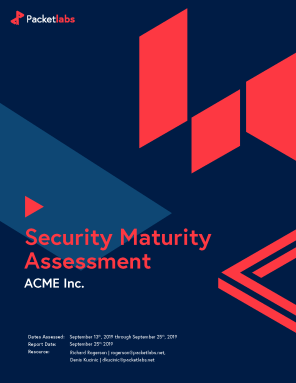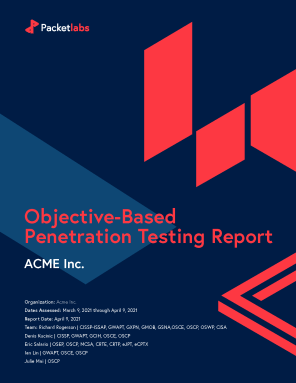Threats What is Attack Surface Mapping?
- The Definition of an Attack Surface
- What Are the Components of an Attack Surface?
- Physical Components
- Digital Components
- Social Components
- Network Components
- Application Components
- Endpoint Components
- Human Components
- Physical Components
- Cloud Components
- Supply Chain Components
- Wireless Components
- IoT Components
- Factors That Impact Attack Surface Mapping
- Technology
- Processes
- People
- Common Challenges in Mapping Attack Surfaces
- Lacking Resources
- Having an Incomplete Asst Inventory
- Not Knowing Emerging Threat Vectors
- Failing to Keep Pace With Technological Changes
- Fortifying Attack Surfaces With Attack Surface Penetration Testing
- Conclusion
Would you like to learn more?
Download our Pentest Sourcing Guide to learn everything you need to know to successfully plan, scope, and execute your penetration testing projects.
What is attack surface mapping, and why does it play a crucial role in crafting your cybersecurity roadmap for 2025 and beyond?
As we have discussed in related resources, attack surface mapping is both a proactive cybersecurity activity and a fundamental step for managing vulnerabilities within an organization's IT infrastructure. The term "attack surface" refers to all potential entry points, such as physical infrastructure, human elements, organizational processes, and various technological components like networks, operating systems, and exposed services.
This means that attack surface mapping (and analysis) is the critical process of identifying and examining all the possible points where an unauthorized user can try to enter or extract data from an environment. Once completed, this map then helps in understanding where an organization's defenses are strong... and where it requires reinforcement.
Let's dive in:
The Definition of an Attack Surface
As defined in OWASP's "Cheat Sheet" series, the attack surface mapping of an application is defined as:
The sum of all paths for data/commands into and out of the application
The code that protects these paths (including resource connection and authentication, authorization, activity logging, data validation and encoding)
All valuable data used in the application, including secrets and keys, intellectual property, critical business data, personal data and PII
And the code that protects these data (including encryption and checksums, access auditing, and data integrity and operational security controls)
The goal of an attack surface analysis is for organizations to understand the risk areas in an application, to make developers and security specialists aware of what parts of the application are open to attack, to find ways of minimizing this, and to be able to flag when and how the attack surface changes (alongside conveying to key stakeholders what this means from a risk perspective.)
While attack surface mapping and analysis is usually done by security architects and penetration testers, developers benefit from monitoring attack surfaces as they design and build and change a system.
When done correctly, attack surface mapping and analysis works to:
Identify what functions and what parts of the system organizations need to test in order to fortify their security posture
Highlight high-risk areas of code that require defense-in-depth protection
Pinpoint when an attack surface has changed and what type of threat assessment is required to counteract these potential vulnerabilities
What Are the Components of an Attack Surface?
An attack surface consists of all the points where an unauthorized user can try to enter an organization's system or extract data from it.
Because these points can be physical, digital, or social, each have their own unique risks and vulnerabilities. That makes understanding each of these components before engaging in attack surface mapping and analysis crucial.
Physical Components
The physical component includes all the hardware that can be manipulated in person to gain unauthorized access to data or systems.
Most commonly, this encapsulates servers in a data center, laptops, mobile devices, or USB drives left unattended.
Digital Components
The digital component is made up of the software, networks, and data.
This includes websites, applications, databases, and any other digital assets that are connected to the Internet or an internal network.
Social Components
The social component, often overlooked, involves the human element of security. This can include tactics like phishing, where attackers trick individuals into giving up sensitive information, or social engineering, where criminals manipulate people into breaking normal security procedures.
This component highlights the importance of in-depth, periodic employee training and awareness as part of a comprehensive security strategy.
Network Components
This includes all the devices and connections that make up your organization’s network.
It’s not only the hardware, like routers and switches, but also the protocols and services running on them. Monitoring and securing this surface involves managing who can access the network and what they can do once they’re on it.
Application Components
Applications, whether developed in-house or acquired from third parties, can have vulnerabilities that attackers exploit.
This surface covers all the software your organization uses, from email clients to enterprise resource planning systems. Securing it means regularly updating applications and checking for vulnerabilities.
Endpoint Components
Endpoints are the devices that connect to your network, like laptops, smartphones, and tablets. Each device is a potential entry point for attackers. Protecting endpoints involves installing security software, enforcing strong authentication, and educating users about safe practices.
Human Components
Unfortunately, people are often the weakest link in security. This surface encompasses the actions and behaviors of people within the organization, such as how they handle sensitive information or respond to suspicious emails. Strengthening this surface involves regular training and awareness programs.
Physical Components
Physical security focuses on protecting the tangible aspects of your organization, such as buildings, servers, and workstations. It includes measures like access control systems, surveillance cameras, and secure equipment disposal.
Cloud Components
As organizations move more of their operations to the cloud, this surface becomes increasingly important. It includes the data stored in cloud services, the cloud-based applications, and the infrastructure itself. Security measures include encryption, access controls, and collaboration with cloud providers to ensure security standards are met.
Supply Chain Components
Your organization’s security is only as strong as the weakest link in its supply chain. This surface includes all the third-party services and products that you rely on. To manage this risk, organizations must assess the security practices of suppliers and establish clear requirements.
Wireless Components
Wireless networks and devices add convenience, but also vulnerabilities. This surface covers all wireless communication within an organization, including Wi-Fi, Bluetooth, and NFC (near-field communications). Protecting it involves securing wireless networks and monitoring them for unauthorized access.
IoT Components
The Internet of Things (IoT) has expanded the attack surface dramatically, with connected devices ranging from cameras to industrial control systems. These devices often lack robust security features, making them easy targets. Security measures include segmenting IoT devices onto separate networks and regularly updating their firmware.
Factors That Impact Attack Surface Mapping
The size and complexity of an attack surface are not static. They change with every new device, application, or user added to an organization's network.
By understanding the factors that influence these changes, teams can strategize how to factor attack surface monitoring into their ongoing cybersecurity roadmap.
Technology
New technologies can also bring new vulnerabilities and potential threats. For example, moving services to the cloud may expand your digital footprint and create additional security challenges. Staying informed about the latest technologies and their security implications is crucial for keeping your attack surface under control.
Processes
The way your organization manages and operates its IT infrastructure can significantly affect its attack surface. Poorly-defined processes for software updates, user access management, and data handling can create unnecessary vulnerabilities. Implementing strong IT governance and management practices can reduce these risks.
People
People are both a strength and a weakness in cybersecurity. User behavior, such as the handling of sensitive information or responding to phishing attempts, can dramatically change the risk profile of an organization. Training and awareness programs are essential for minimizing human-related vulnerabilities and ensuring that everyone understands their role in maintaining security.
Common Challenges in Mapping Attack Surfaces
Despite its critical importance, attack surface mapping comes with a set of challenges that organizations must navigate. On average, companies take about 272 days to identify and 69 days to contain a breach–and, with the average cost of a cyberattack having risen by 15% over the past three years to now sit at USD $4.45 million, proactive cybersecurity efforts have never been more critical.
Most commonly, organizations generally face the following hurdles:
Lacking Resources
Many organizations struggle with limited cybersecurity budgets and a shortage of skilled personnel. This can make comprehensive attack surface mapping and analysis difficult, as these activities require both time and specialized knowledge.
Having an Incomplete Asst Inventory
Keeping an up-to-date inventory of all assets is challenging, especially for organizations with complex IT environments or those undergoing rapid digital transformation. Missing assets from the inventory means potential vulnerabilities may go unnoticed.
Not Knowing Emerging Threat Vectors
The cyber threat landscape is constantly evolving, with attackers regularly developing new techniques and tools. Organizations often find it hard to keep pace with these changes, leading to gaps in their understanding of their attack surface.
Failing to Keep Pace With Technological Changes
As new technologies are adopted, they can introduce new vulnerabilities and expand the attack surface in unexpected ways. Organizations may struggle to assess the security implications of these technologies promptly and accurately.
Fortifying Attack Surfaces With Attack Surface Penetration Testing
Attack Surface Penetration Testing identifies sensitive data in public places and is a critical aspect of cybersecurity and threat intelligence. It involves the search and discovery of confidential information or vulnerabilities that could be exploited by malicious actors to infiltrate your organization.
Attack Surface Penetration Testing detects known or unknown assets from a threat actor’s perspective, granting organizations a view from outside of their team. Once executed, this exercise gives your team the opportunity to identify which functions need testing for security vulnerabilities–and which areas of your attack surface need further refinement.
Why invest in Attack Surface Pentesting?
Thoroughly identify all attack surface types and components
In-depth risk assessment and reporting
Maximized vulnerability identification across earch engines, historical website records, exposed endpoints, public code repositories, employee Internet activity, mail misconfigurations, and more via our partnership with Flare.io
Conclusion
Addressing these challenges requires a strategic approach that balances available resources with the need for comprehensive security. Prioritizing critical assets, leveraging automation, and seeking external expertise when necessary can help overcome these obstacles and enhance your organization’s security posture.
Mapping and analysis are critical because, otherwise, defending against attacks is like trying to guard a fortress without knowing all of its entrances. It provides a clear view, allowing for a more targeted and effective defense strategy.
Let's Connect
Share your details, and a member of our team will be in touch soon.
Reports

Cyber Maturity Assessment Report
Packetlabs assessed the security control capabilities of ACME Inc.’s security program using the ISO/IEC 27001:2022 framework.
Download Sample Report
OBPT Sample Report
Packetlabs’ OBPT methodology evaluates the security controls across people, processes and technology in order to identify potential areas of weakness.
Download Sample ReportExplore in-depth resources from our ethical hackers to assist you and your team’s cyber-related decisions.

September 13 - Blog
Why Multi-Factor Authentication is Not Enough
Knowing is half the battle, and the use and abuse of common frameworks shed insight into what defenders need to do to build defense in depth.

November 19 - Blog
The Top Cybersecurity Statistics for 2024
The top cybersecurity statistics for 2024 can help inform your organization's security strategies for 2025 and beyond. Learn more today.

October 24 - Blog
Packetlabs at SecTor 2024
Packetlabs is thrilled to have been a part of SecTor 2024. Learn more about our top takeaway's from this year's Black Hat event.







